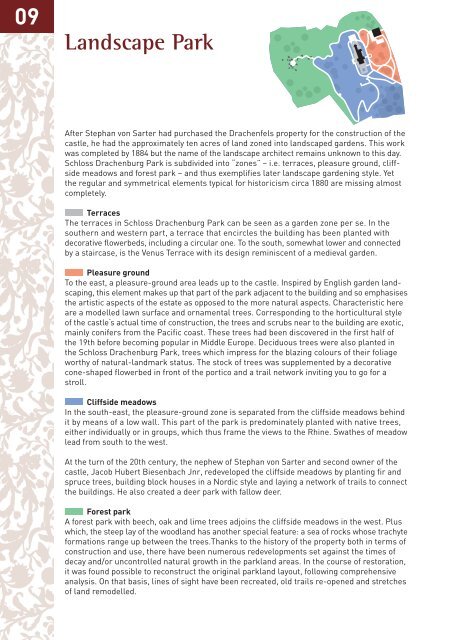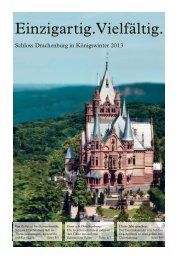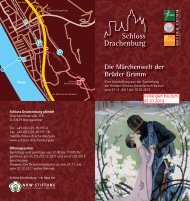North Tower - Schloss Drachenburg
North Tower - Schloss Drachenburg
North Tower - Schloss Drachenburg
You also want an ePaper? Increase the reach of your titles
YUMPU automatically turns print PDFs into web optimized ePapers that Google loves.
09<br />
Landscape Park<br />
After Stephan von Sarter had purchased the Drachenfels property for the construction of the<br />
castle, he had the approximately ten acres of land zoned into landscaped gardens. This work<br />
was completed by 1884 but the name of the landscape architect remains unknown to this day.<br />
<strong>Schloss</strong> <strong>Drachenburg</strong> Park is subdivided into “zones” – i.e. terraces, pleasure ground, cliffside<br />
meadows and forest park – and thus exemplifi es later landscape gardening style. Yet<br />
the regular and symmetrical elements typical for historicism circa 1880 are missing almost<br />
completely.<br />
Terraces<br />
The terraces in <strong>Schloss</strong> <strong>Drachenburg</strong> Park can be seen as a garden zone per se. In the<br />
southern and western part, a terrace that encircles the building has been planted with<br />
decorative fl owerbeds, including a circular one. To the south, somewhat lower and connected<br />
by a staircase, is the Venus Terrace with its design reminiscent of a medieval garden.<br />
Pleasure ground<br />
To the east, a pleasure-ground area leads up to the castle. Inspired by English garden landscaping,<br />
this element makes up that part of the park adjacent to the building and so emphasises<br />
the artistic aspects of the estate as opposed to the more natural aspects. Characteristic here<br />
are a modelled lawn surface and ornamental trees. Corresponding to the horticultural style<br />
of the castle‘s actual time of construction, the trees and scrubs near to the building are exotic,<br />
mainly conifers from the Pacifi c coast. These trees had been discovered in the fi rst half of<br />
the 19th before becoming popular in Middle Europe. Deciduous trees were also planted in<br />
the <strong>Schloss</strong> <strong>Drachenburg</strong> Park, trees which impress for the blazing colours of their foliage<br />
worthy of natural-landmark status. The stock of trees was supplemented by a decorative<br />
cone-shaped fl owerbed in front of the portico and a trail network inviting you to go for a<br />
stroll.<br />
Cliffside meadows<br />
In the south-east, the pleasure-ground zone is separated from the cliffside meadows behind<br />
it by means of a low wall. This part of the park is predominately planted with native trees,<br />
either individually or in groups, which thus frame the views to the Rhine. Swathes of meadow<br />
lead from south to the west.<br />
At the turn of the 20th century, the nephew of Stephan von Sarter and second owner of the<br />
castle, Jacob Hubert Biesenbach Jnr, redeveloped the cliffside meadows by planting fi r and<br />
spruce trees, building block houses in a Nordic style and laying a network of trails to connect<br />
the buildings. He also created a deer park with fallow deer.<br />
Forest park<br />
A forest park with beech, oak and lime trees adjoins the cliffside meadows in the west. Plus<br />
which, the steep lay of the woodland has another special feature: a sea of rocks whose trachyte<br />
formations range up between the trees.Thanks to the history of the property both in terms of<br />
construction and use, there have been numerous redevelopments set against the times of<br />
decay and/or uncontrolled natural growth in the parkland areas. In the course of restoration,<br />
it was found possible to reconstruct the original parkland layout, following comprehensive<br />
analysis. On that basis, lines of sight have been recreated, old trails re-opened and stretches<br />
of land remodelled.







